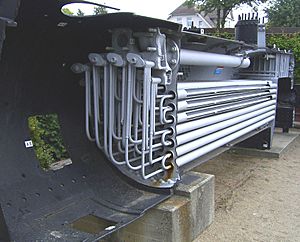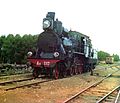Superheater facts for kids
A superheater is a special device that makes steam much hotter than it normally would be. When water boils, it creates steam. This steam often has tiny drops of water still mixed in, which we call saturated steam or "wet steam." A superheater's job is to take this wet steam and heat it up even more, turning it into dry steam. This dry steam is very powerful and useful in many different machines and factories.
Contents
What is Superheated Steam?
When water turns into steam, it's usually at a specific temperature. For example, at sea level, water boils at 100 degrees Celsius (212 degrees Fahrenheit). The steam created at this temperature is called saturated steam. If you keep heating this steam without letting it turn back into water, its temperature will rise above 100 degrees Celsius. This hotter, drier steam is what we call superheated steam.
Why is Dry Steam Important?
Dry steam is much better for machines like steam turbines or engines. Here's why:
- More Power: Superheated steam holds more energy than wet steam. This means it can make engines work harder and more efficiently.
- Prevents Damage: Wet steam contains tiny water droplets. These droplets can hit and damage the fast-moving parts inside a turbine or engine, like the blades. Dry steam is pure gas, so it doesn't cause this kind of wear and tear.
- Better Efficiency: Using superheated steam helps power plants and factories get more work done with less fuel. This saves energy and money.
How Superheaters Work
A superheater usually consists of many long tubes. These tubes are placed in a very hot area, often near the furnace of a boiler. As the wet steam flows through these hot tubes, it absorbs more heat. This extra heat boils away any remaining water droplets and raises the steam's temperature well above its boiling point, turning it into superheated dry steam.
Types of Superheaters
Superheaters are designed in different ways depending on how they get their heat.
Convection Superheater
A convection superheater gets its heat from hot gases that flow around its tubes. These hot gases are usually the leftover heat from a boiler's furnace. The heat transfers from the hot gases to the steam inside the tubes.
Radiant Superheater
A radiant superheater is placed directly in the hottest part of a furnace. It absorbs heat directly from the flames and very hot walls of the furnace, much like how you feel heat from a campfire.
Separately Fired Superheater
Some superheaters have their own separate furnace or heating system. This allows them to heat the steam to a very precise temperature, independent of the main boiler. This type is used when very specific steam temperatures are needed for industrial processes.
Where Are Superheaters Used?
Superheaters are a key part of many important systems:
- Power Plants: They are essential in power plants that use steam to generate electricity. The superheated steam drives large turbines connected to generators.
- Steam Locomotives: Older steam trains used superheaters to make their engines more powerful and efficient, allowing them to pull heavier loads faster.
- Industrial Processes: Many factories use superheated steam for various processes, such as heating chemicals, drying materials, or sterilizing equipment.
Images for kids
-
Early color photograph from Russia taken by Sergey Prokudin-Gorsky in 1910 of steam locomotive with a superheater
See also
 In Spanish: Supercalentador para niños
In Spanish: Supercalentador para niños




